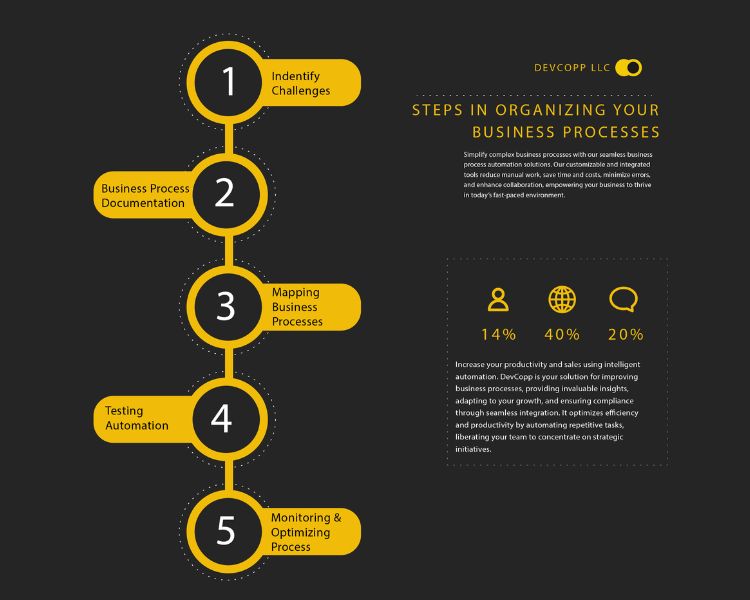Simplifying Productivity with Business Process Automation that Works
Simplify complex business processes with our seamless business process automation solutions. Our customizable and integrated tools reduce manual work, save time and costs, minimize errors, and enhance collaboration, empowering your business to thrive in today’s fast-paced environment.
Simplifying Productivity with Business Process Automation that Works

Simplify your productivity with our seamless business process automation solutions. Our customizable and integrated tools reduce manual work, save time and costs, minimize errors, and enhance collaboration, empowering your business to thrive in today’s fast-paced environment.
Why Automate Your Business with DevCopp?
DevCopp is your solution for improving business processes, providing invaluable insights, adapting to your growth, and ensuring compliance through seamless integration. It optimizes efficiency and productivity by automating repetitive tasks, liberating your team to concentrate on strategic initiatives.
Streamlined Operations
Standardizing processes and employing business process management to improve efficiency consistency, and customer satisfaction.
Data-Driven Insights
Enhances visibility using artificial intelligence and intelligent automation to collect, analyze internal and external data, and deliver actionable insights for informed decision-making.
Seamless Integration
Integrating research, analysis, technical expertise, and business process automation tools guides design for an enhanced core processes, intelligent automation and digital transformation.
Cost Savings
Reducing labor expenses, human error, enhancing efficiency, improving accuracy, lowering operational costs, and ensuring compliance while scaling seamlessly with business growth.

Assessing Business Process Challenges
The initial step in business process automation is identifying the relevant business processes in place, providing visibility into operations, finance, human resources, or product development, depending on the organization.

Internal Challenges
Addressing internal challenges is crucial in successful business process automation. We streamline your processes to enhance efficiency, overcome obstacles, and ensure customer satisfaction.

Automation Tools
We utilize cutting-edge tools for business process automation to drive efficiency and deliver results. Our arsenal of automation solutions ensures seamless project execution.
Assessing Business Process Challenges
The initial step in business process automation is identifying the relevant business processes in place, providing visibility into operations, finance, human resources, or product development, depending on the organization.

Internal Challenges
Addressing internal challenges is crucial in successful business process automation. We streamline your processes to enhance efficiency, overcome obstacles, and ensure customer satisfaction.
Automation Tools
We utilize cutting-edge tools for business process automation to drive efficiency and deliver results. Our arsenal of automation solutions ensures seamless project execution.
Business Process Documentation
DevCopp identifies workflow automation opportunities, streamlines processes, and boosts productivity, charting a path to an agile, cost-effective, and innovative future for the organization.
It ensures that automated workflows align with organizational standards, facilitating efficient knowledge transfer, resulting in substantial efficiency gains and heightened productivity

Clear Objective
Leveraging specialized tools and advanced technologies to establish clear project objectives, we prioritize transparency and focus on achieving better business process management.

Identify Processes
Employing advanced tools for precise process identification, enhancing operational efficiency and reduce errors.

Business Process Documentation
DevCopp identifies workflow automation opportunities, streamlines processes, and boosts productivity, charting a path to an agile, cost-effective, and innovative future for the organization.
It ensures that automated workflows align with organizational standards, facilitating efficient knowledge transfer, resulting in substantial efficiency gains and heightened productivity.

Clear Objective
Leveraging specialized tools and advanced technologies to establish clear project objectives, we prioritize transparency and focus on achieving better business process management.
Identify Processes
Employing advanced tools for precise process identification, enhancing operational efficiency and reduce errors.
your automation solutions
Find the Plan That's Right For You
Enhance your business operations effortlessly. Our flexible pricing fits your needs, and we’re aligned with leading technologies in CMS, CRM, payment gateways, and communication platforms.
Plus, our solutions are API-friendly, ensuring seamless integration with your existing systems. Simple, efficient, and tailored for you!
Basic Plan
Premium Plan
Pro Plan
Monthly Plan
$1,399
$1,999
$3,599
Features
Capped at
Month to Month
Cancel Anytime
No Long Term Contracts
Automation & Workflows
Custom Modules
Dedicated Project Manger
System wide core support
CMS Support & Maintenance
your automation solutions
Find the Right Plan For You
Enhance your business operations effortlessly. Our flexible pricing fits your needs, and we’re aligned with leading technologies in CMS, CRM, payment gateways, and communication platforms.
Plus, our solutions are API-friendly, ensuring seamless integration with your existing systems. Simple, efficient, and tailored for you!
Basic Plan
Monthly Plan
$1,399
Capped at
Month to Month
Cancel Anytime
No Long Term Contracts
Automation & Workflows
Custom Modules
Premium Plan
Monthly Plan
$1,999
Capped at
Month to Month
Cancel Anytime
No Long Term Contracts
Automation & Workflows
Custom Modules
Dedicated Project Manger
System wide core support
Pro Plan
Monthly Plan
$3,599
Capped at
Month to Month
Cancel Anytime
No Long Term Contracts
Automation & Workflows
Custom Modules
Dedicated Project Manger
System wide core support
CMS Support & Maintenance

Mapping the Business Processes
Once the processes have been identified, the next step is to map out the existing business process in order to understand how work is currently being performed and where improvements can be made. This is done through a comprehensive analysis of the current workflow and the various steps that are involved in the entire process.

Select the Right Automation Tools
Selecting the right tools is pivotal in your business automation process. DevCopp helps you make the ideal choices to increase efficiency and seize automation opportunities.

Design the Automated Workflow
Crafting the perfect automated workflow is essential for your business. We specialize in creating efficient, customized workflows to elevate your automated processes.
Mapping the Business Processes
Once the processes have been identified, the next step is to map out the existing business process in order to understand how work is currently being performed and where improvements can be made. This is done through a comprehensive analysis of the current workflow and the various steps that are involved in the entire process.

Select the Right Automation Tools
Selecting the right tools is pivotal in your business automation process. DevCopp helps you make the ideal choices to increase efficiency and seize automation opportunities.
Design the Automated Workflow
Crafting the perfect automated workflow is essential for your business. We specialize in creating efficient, customized workflows to elevate your automated processes.
Testing Business Process Automation
Systematic QA ensures product quality, identifies and rectifies issues, and promotes responsive design, reducing risks, and saving time and resources during development.

Thorough Testing
We leave no stone unturned in our testing process. Thorough and meticulous, we ensure your automated business processes perform flawlessly.

Implement Incrementally
Implementing incrementally for a smooth transition, aligning each step with your business objectives seamlessly.

Testing Business Process Automation
Systematic QA ensures product quality, identifies and rectifies issues, and promotes responsive design, reducing risks, and saving time and resources during development.

Thorough Testing
We leave no stone unturned in our testing process. Thorough and meticulous, we ensure your automated business processes perform flawlessly.
Implement Incrementally
Implementing incrementally for a smooth transition, aligning each step with your business objectives seamlessly.

Monitor and Optimize Business Processes
Identifying areas for improvement is the first step. Once these are identified, we develop a comprehensive plan for process optimization, utilizing tools like process mapping and automation. Our approach involves crafting new workflows, removing redundant steps, and updating technologies, resulting in streamlined processes and enhanced overall efficiency.

Scale and Expand
Scaling and expanding your automated systems is vital for growth. We ensure your automation solutions adapt seamlessly to evolving business needs.

Stay Informed
Staying informed is key to automation success. We provide ongoing insights and updates on your process type to keep your systems optimized.

Feedback Loop
e value your input to refine and enhance your automated processes. With this, we conduct a survey from multiple people in the organization to improve efficiency.
Monitor and Optimize Business Processes
Identifying areas for improvement is the first step. Once these are identified, we develop a comprehensive plan for process optimization, utilizing tools like process mapping and automation. Our approach involves crafting new workflows, removing redundant steps, and updating technologies, resulting in streamlined processes and enhanced overall efficiency.

Scale and Expand
Scaling and expanding your automated systems is vital for growth. We ensure your automation solutions adapt seamlessly to evolving business needs.
Stay Informed
Staying informed is key to automation success. We provide ongoing insights and updates on your process type to keep your systems optimized.
Feedback Loop
e value your input to refine and enhance your automated processes. With this, we conduct a survey from multiple people in the organization to improve efficiency.